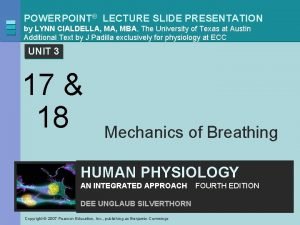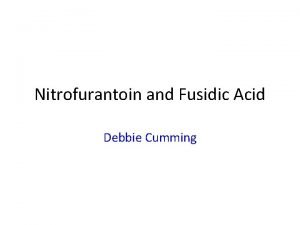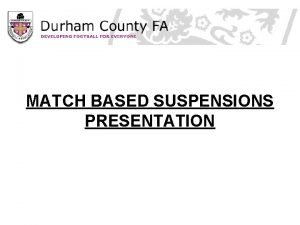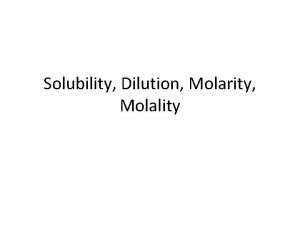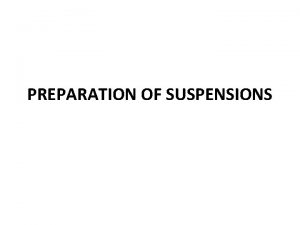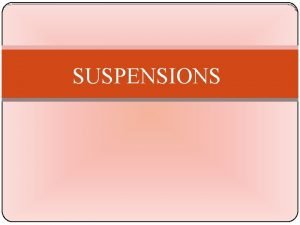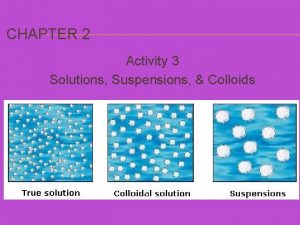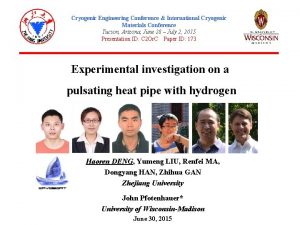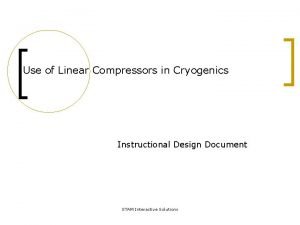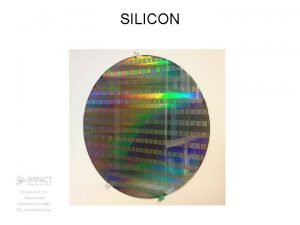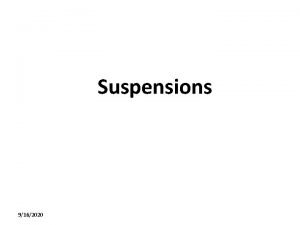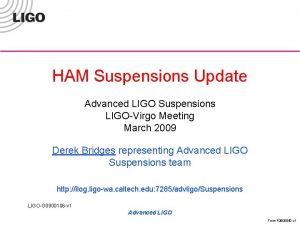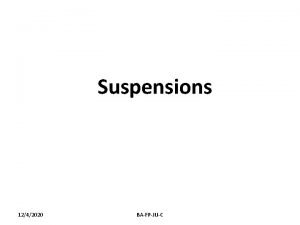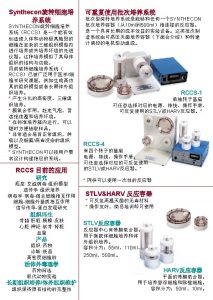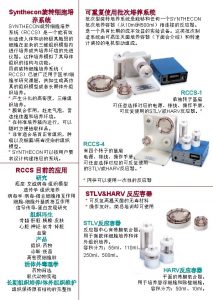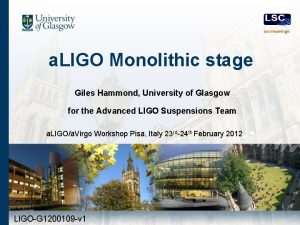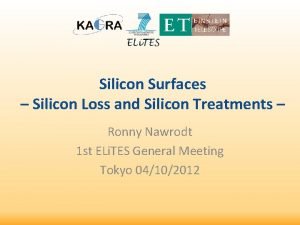Cryogenic Silicon Suspensions Giles Hammond 1 A Cumming
















- Slides: 16

Cryogenic Silicon Suspensions Giles Hammond 1, A. Cumming 1, R. Douglas 1, K. Haughian 1, J. Hough 1, I. Martin 1, R. Nawrodt 2, S. Rowan 1, C. Schwarz 2, A. A. Van Veggel 1 1 SUPA, Institute for Gravitational Research, University of Glasgow 2 Friedrich Schiller University, Jena 4 th Einstein Telescope Symposium, Hannover, 4 -5 th December 2012

Introduction • Future detectors will need careful design of the test mass mirrors and suspensions to provide suitably low thermal noise • One possible way to reduce thermal noise is to cool test masses and suspensions • Suspension thermal noise originates from materials that make up the test masses, suspension fibres and their attachments, so use ultra-low mechanical loss materials • Silicon is one proposed low mechanical dissipation material for future detectors • Analysis of the limitations of silicon and the performance gains we can expect are crucial a. LIGO lower monolithic silica stage 1

Low Temperature Operation • For low temperature operation of the test mass (<50 K) any heat input by the detector laser beam will be extracted via conduction up the suspension fibres • This places a limit on the fibre diameter (and therefore the ultimate suspension thermal noise performance) – too thin results in a heat bottleneck • Penultimate mass at 4 K, 18 k. W laser power with 1 ppm absorption 2

Case Study: Loss Terms • Consider the following case study: 200 kg test mass, 18 k. W laser power, with 1 ppm absorption, ribbon geometry fibres (width w, thickness t), penultimate mass at 4 K • Calculate the minimum suspension fibre area to hold the test mass at a given temperature and compare with thermal extraction limit. • Suspension thermal noise is then calculated from the standard loss terms: Thermoelastic loss: Surface loss: Bulk loss fitted from Mc. Guigan (78) Total mechanical loss: with dissipation dilution: Thermal noise power spectral density: A. M. Gretarsson et al. , Phys. Rev. A, 2000 G. Cagnoli and P. A. Willems, Phys. Rev. B, 2002 A. Cumming, et al. , CQG, 26 215012, 2009 D. F. Mc. Guigan et al. J. Low Temp. Phys. 1978 R. Nawrodt et al. submitted CQG, 2012 3

Case Study: Mechanical Loss • Longer suspensions have lower surface loss (fibres thicker to maintain heat extraction) • Below ~50 K the dominant loss term is surface loss and bulk loss • Thermoelastic loss rapidly becomes insignificant with decreasing temperature, due both to temperature and thermoelastic null at ~18 K. 4

Case Study: Dilution • In cases where fibres terminate in rigid attachment points the dilution is • This is an approximation as real suspensions do not terminate at an infinitely stiff attachment • Use ANSYS to predict stored energy and compare with idealistic case Vary length • In the MATLAB model (1/D) is multiplied by a factor 10 to account for this effect. 5

Case Study: Thermal Noise @10 Hz • Longer suspensions improve the noise performance due to better dissipation dilution • The remainder of the talk will focus on the test mass at 20 K 6

Strength of Silicon • These proposed suspensions rely on the structural strength of silicon being at appropriate levels – e. g. absolute minimum strength of 200 MPa in the case study (650 MPa with a safety factor of 3) • Tensile strength tests have recently undertaken on silicon samples with different surface treatments – polished, etched, Si 3 N 4, wet oxidised [1] • Samples 45 mm x 3 mm x 0. 5 mm, and 45 mm x 2. 2 mm x 0. 5 mm Silicon sample Articulation via universal joints top and bottom, to ensure force along axis of sample Sample bonded between metal attachment pieces with Araldite 2012 epoxy Silicon sample Simple alignment jig from aluminium angle, to ensure sample centred and aligned parallel to fuse ends while curing. [1] K. Petersen, Proceedings of IEEE, 70, 5 pp 420 (1982) Lower joint free to rotate to allow sample to experience minimal torsional forces on sample Applied force

Measured Strengths 5, 0 E+08 Average Strength Tensile Strength (Pa) 4, 5 E+08 Individual datapoints 4, 0 E+08 3, 5 E+08 3, 0 E+08 2, 5 E+08 2, 0 E+08 1, 5 E+08 1, 0 E+08 5, 0 E+07 0 <110>1 <100>2 <100>3 Etched 4 <110> Si 3 N 4 <100> 5 Si 3 N 4 <100> <110> 6 7 Oxidised <110> 8 Si 3 N 4 Oxidised <100> 9 Si 3 N 4 Oxidised 10

Conclusions from Strength Tests • Some clear trends can be seen: • Etched samples are ~ 2 stronger than those with mechanically polished edges – likely due to higher quality surfaces, with less polishing damage • Si 3 N 4 coated samples are no stronger than the equivalent untreated silicon (<100> seems weaker, unknown why) – implies the edge surface quality (where no Si 3 N 4 present) is limiting factor • All oxidised samples show improvement in strength (~factor of 2), and oxidised samples are those that have exhibited the highest absolute strength values • No current trend can be seen with oxide thickness (not enough statistics) • Scatter of data is large – consistent with expectation for brittle materials • The largest load supported was 660 N • There is a possibility to improve the strength through surface treatment

Additional Tests - Hanging a Mass • A 4 ‘fibre’ test suspension was also constructed • 39 kg, 52 kg, 65 kg, 78 kg suspensions hung successfully • Maximum demonstrated 126 MPa on 4 fibres (90 kg on 4 x 45 mmx 3. 5 x 0. 5 mm ‘fibres’) – hung for ~3 hours before failure (likely failure due to heavy vibration in the laboratory) • This is a very encouraging first test Universal joints top and bottom, to minimise bending stress on silicon Mild steel plates, 13 kg each Silicon Jack

Performance of a 20 K Silicon Suspension Oxidised strength is higher allowing a thinner fibre (higher dissipation dilution) but surface loss is significantly higher at 10 -10 [1] Pendulum resonances Vertical resonances Violin modes 0. 7 mm thick ribbon is limiting case – thinner fibres would not be able to extract the heat deposited by laser [1] B. E. White Phys Rev Let 75 (24), pp 4437 (1995) 11

Performance of a 20 K Silicon Suspension Oxidised strength is higher allowing a thinner fibre (higher dissipation dilution) but surface loss is significantly higher at 10 -10 [1] Pendulum resonances Vertical resonances Violin modes 0. 7 mm thick ribbon is limiting case – thinner fibres would not be able to extract the heat deposited by laser [1] B. E. White Phys Rev Let 75 (24), pp 4437 (1995) 12

Suspension Design Drivers • Vertical compliance: • The a. LIGO design utilises laser heating to soften the 3 mm diameter fused silica stock and adjust the stock angle and mirror pitch • This is not possible with Silicon so another method to add vertical compliance is necessary => Silicon cantilever springs. This has the benefit of applying additional vertical isolation to the suspension chain. • Fibre Attachment • A reproducible and removable method to attach of attaching fibres to the mirror and penultimate mass is required • Need to be careful that attachment method does not compromise thermal noise • bonded interface • R&D and additional loss measurements are needed to develop the optimum approach 13

Conclusion • Silicon is a promising prospective material for future detector suspensions offering improvements of the order 70 x a. LIGO room temperature silica • The limiting dissipation is surface and bulk loss at low temperature (<50 K) • The stronger silicon can be made, the greater the performance gain • Silicon strength has been demonstrated to be improved with suitable surface treatment of the material • Future work includes deeper investigation of surface treatments of silicon, aiming to improve strength, reliability and mechanical dissipation, including: • Apply oxide to etched samples • Investigating strength as function of oxide layer thickness • Application of Si 3 N 4 to all surfaces of samples • Finite Element Analysis of the full suspension including bonded interfaces • Additional R&D is needed to: • Provide vertical compliance via cantilever springs • Demonstrate repeatable attachment of fibres to the mirrors 14

Extra Slide 15
 Harley cumming
Harley cumming Vincent langlois cumming
Vincent langlois cumming Diffusion rate
Diffusion rate Bing
Bing Benjamin cumming
Benjamin cumming Depolarization
Depolarization Durham fa suspensions
Durham fa suspensions Saturation
Saturation Ingredients for suspensions
Ingredients for suspensions Suspension meaning
Suspension meaning Saturated aolution
Saturated aolution Is cereal and milk a solution colloid or suspension
Is cereal and milk a solution colloid or suspension Cold stretching cryogenic vessel
Cold stretching cryogenic vessel Cryogenic instrumentation
Cryogenic instrumentation International cryogenic engineering conference
International cryogenic engineering conference Independence cryogenic engineering
Independence cryogenic engineering Complete cryogenic services
Complete cryogenic services


